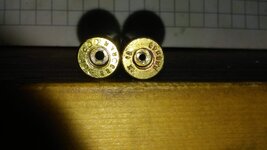- Messages
- 109
- Reactions
- 72
So I just started prepping my stash of mixed .223/5.56 cases to start loading. This is my first real go with these. While using my sizing and de priming die, I noticed that some were hard to do full stroke on. Upon inspection, it looks like they have a much smaller flash hole resulting in a lip of the flash hole being pushed into the primer pocket. How do I get rid of this anomaly as I'm sure it will effect the performance of the primer.
Also, is there something maybe I'm doing wrong? Any way to avoid it? I would say it's about 10% of them and all were crimped.
Thanks.
Also, is there something maybe I'm doing wrong? Any way to avoid it? I would say it's about 10% of them and all were crimped.
Thanks.












